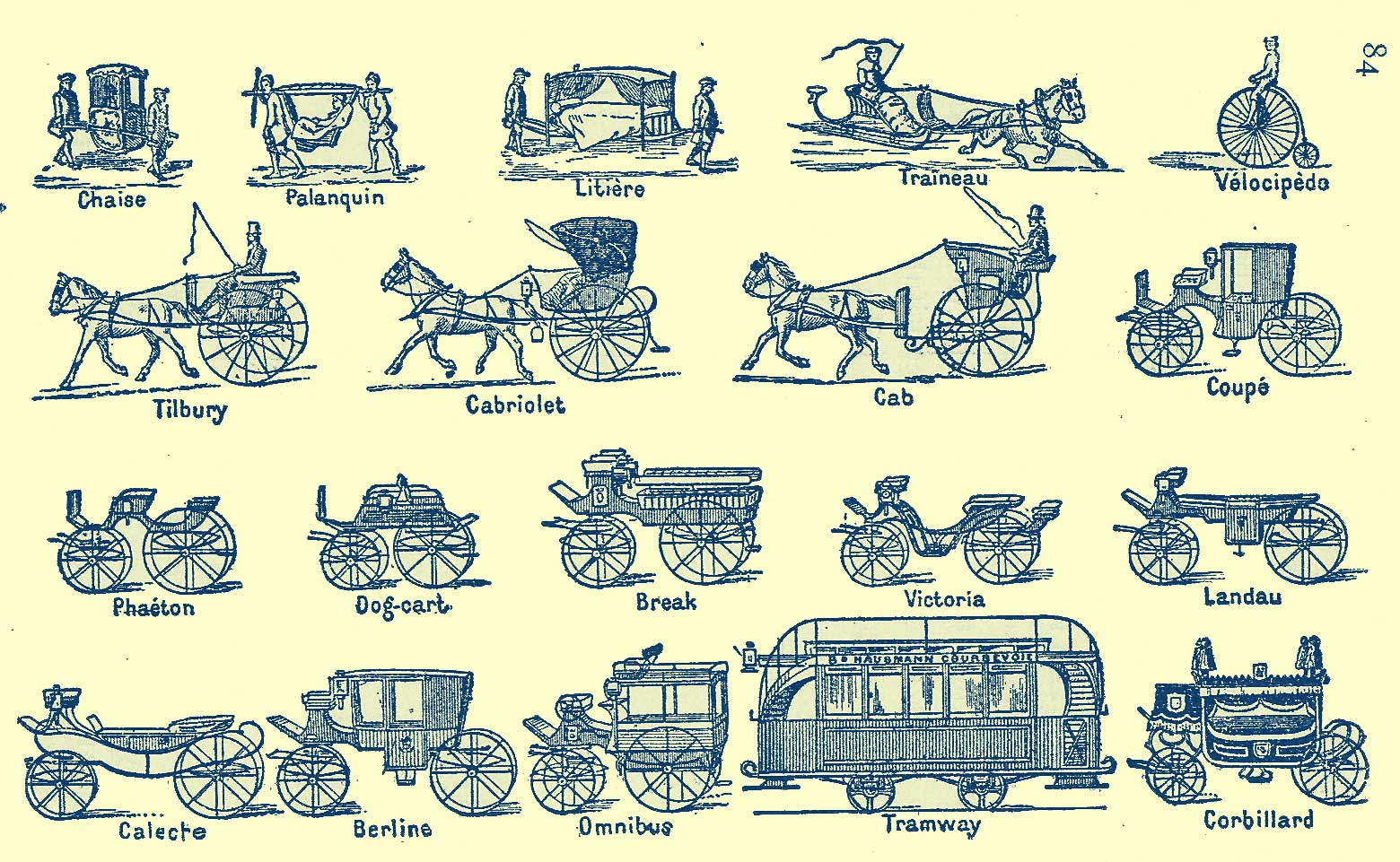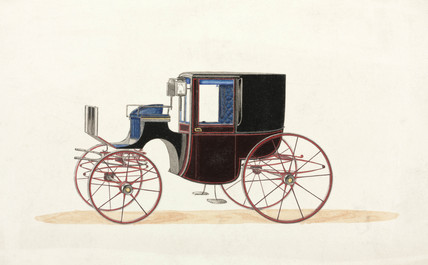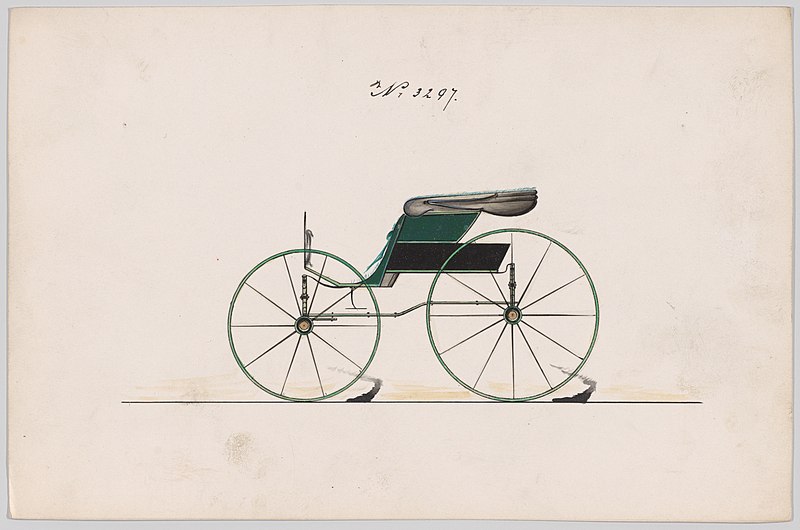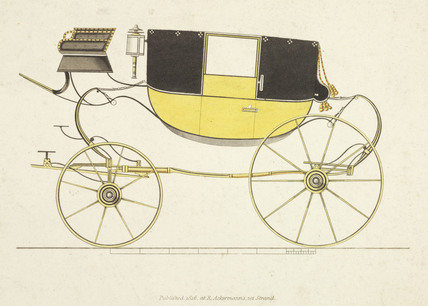I will admit it, I get the conveyances of the Regency confused all the time. So here is a primer on all the assorted vehicles of the Regency era for your (and most especially, my) use.

- Barouche: A four-wheeled carriage, with a falling top, a seat on the outside for the driver, and two double seats on the inside arranged so that the sitters on the front seat face those on the back seat. It’s “light construction” and little protection from inclement weather made this a summer carriage.

- Break (Brake): An open country four wheeled carriage, capable of carrying up to six sportsmen with space for their dogs, guns and game. Typically open air with a raised box for a driver.
- Brougham: (Pronounced broom or brohm) A light-fourwheeled carriage usually pulled by a pair of horses. It was like a town coach in that it had a hard top. Sat two comfortably, with forewheels capable of sharp turns, and a box seat on front for a driver and footman or passenger. Used broughams were often purchased and reborn as hackney carriages.

- Cabriolet: A light, two wheeled hooded curricle meant to be driven from one of two passenger seats with a running board for a tiger or groom. It had a folding top, and a large rigid apron. Taxi-cab or hansom cab was a short hand of the term cabriolet, although would quickly be replaced by hackney carriages for taxi.
.jpg)
- Calash: An early version of the barouche, it was a light, four wheeled and hooded vehicle.
- Chaise: Sometimes called chay or shay, is a light two- or four-wheeled traveling or pleasure carriage, with a folding hood or calash top for one or two people. Originally a sedan-chair, the term changed to a wheeled vehicle pulled by one horse during the opening phases of the French Revolution.
- Coach: Four wheeled, enclosed with windows and a curved underbody and a roof included in the framing of the body, it usually seated four. A team of horses (two or more) were controlled by a coachman and/or one or more postilions on an elevated box seat. A coach together with the horses, harness and attendants is called a turnout.
- Curricle: A light two-wheeled chaise or chariot large enough for a driver and passenger, typically drawn by a carefully matched pair of horses. A favorite of young bucks who liked to drive himself at a canter, they were infamous for accidents and causing drivers injuries.
- Dogcart: A light, two wheeled one horse drawn vehicle typically designed for sporting shooters with a box directly behind the driver’s seat for one or more hunting dogs. The dog box could be converted to a second seat. A young or small groom (tiger) might also stand on the platform at the rear of the dogcart. This country vehicle was also useful for short jaunts, such as trips to the village.
.png)
- Gig: This was a very popular vehicle in the country. It was a light two wheeled cart that held one or two persons and it was drawn by one horse. A gig was the most common vehicle as it was affordable, although not the most fashionable. A Tilbury was a type of gig. Through history the term “Gig” would have been applied to almost any two wheel vehicle.

- Landau: Similar to a barouche in that it held four passengers and was pulled by four horses, but a landau was convertible, with two folding hoods that could be raised to cover all four passengers or left open to take in the sights. Light weight, it was suspended on elliptical springs, and pulled by a four horses. There was typically a front, raised driver’s upholstered bench-seat, but a landau could be postilion-driven, and there was usually a separate groom’s seat, sprung above and behind the rear axle, saving the groom from having to stand on a running board.
 The landau was the ultimately city carriage luxury conveyance, and its low styled shell meant to show off the finery of its occupants during slow, fashionable strolls.
The landau was the ultimately city carriage luxury conveyance, and its low styled shell meant to show off the finery of its occupants during slow, fashionable strolls. - Phaeton: Sporty open carriage drawn by a single or pair of horses, it was light with typically four large wheels. The minimal body made the phaeton fast and dangerous. The rather self-consciously classicizing name refers to the disastrous ride of mythical Phaëton, son of Helios, who nearly set the earth on fire while attempting to drive the chariot of the sun.

- Pony-cart: Small, light two-wheeled vehicle to be drawn by a pony.
- Post-chaise: A fast carriage for travelling post in the 18th and early 19th century, it had a closed body on four wheels and was drawn by two to four horses. It could seat two-four people. The driver, especially when there was no coachman, rode postillion on the near horse of a pair or of one of the pairs attached to the post-chaise.
- Town Coach: This coach was very like a landau, but it had a hard top and was typically massive, drawn by up to six heavy horses. May also be referred to as a closed carriage. Only the very rich could afford a town coach and it would typically have armorial bearings painted on the doors.

References:
http://www.arnkarnk.plus.com/carriages_glossary.htm
http://en.wikipedia.org/wiki/Coach_(carriage)
http://smithandgosling.wordpress.com/2013/09/15/treatise-on-carriages/
http://www.georgianindex.net/horse_and_carriage/carriages.html
http://www.likesbooks.com/carriages.html










